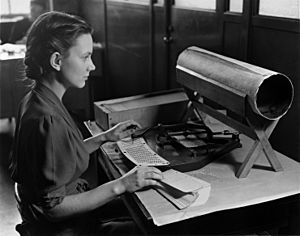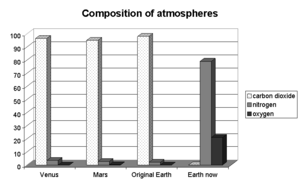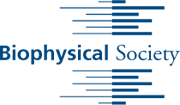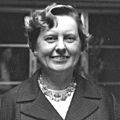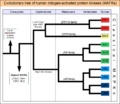Margaret Oakley Dayhoff facts for kids
Quick facts for kids
Margaret Oakley Dayhoff
|
|
|---|---|
 |
|
| Born |
Margaret Belle Oakley
March 11, 1925 |
| Died | February 5, 1983 (aged 57) |
| Known for | Substitution matrices one-letter code |
| Scientific career | |
| Fields | Bioinformatics |
| Institutions | Columbia University |
| Influences | George Kimball |
Margaret Belle Dayhoff (March 11, 1925 – February 5, 1983) was an American physical chemist. She was a true pioneer in a field called bioinformatics. This field uses computers to understand biology and medicine.
Margaret Dayhoff was a professor at Georgetown University Medical Center. She was also a famous researcher at the National Biomedical Research Foundation. There, she was one of the first to use math and computers in biochemistry. She spent her career finding ways to use new computer technology to help biology and medicine. She created important databases for proteins and nucleic acids. She also made tools to search these databases. She developed one of the first substitution matrices, called PAM. She also created the one-letter code for amino acids. This helped make data files smaller when computers used punch cards.
She earned her PhD from Columbia University. She developed computer methods to figure out the energy of different organic compounds. She then did more studies at the Rockefeller Institute and the University of Maryland. In 1959, she joined the National Biomedical Research Foundation. She was the first woman to hold an office in the Biophysical Society. She was also the first person to be both secretary and president of the society.
Contents
Early Life and Education

Margaret Dayhoff was born in Philadelphia. When she was ten, her family moved to New York City. She was a very smart student from a young age. She was the top student in her class at Bayside High School in 1942.
She received a scholarship to Washington Square College at New York University. In 1945, she graduated with high honors in mathematics. She was also chosen for the Phi Beta Kappa Society, which is for top students.
Pioneering Computer Research
Margaret Dayhoff started her PhD in quantum chemistry at Columbia University. She was one of the first to use computers for chemistry research. She used special punch-card machines to calculate the energy of complex organic molecules. Her work with data was so impressive that she won a special fellowship. This gave her access to advanced IBM computers.
After her PhD, Dayhoff continued her research. In 1952, she moved to Maryland with her family. She later worked at the University of Maryland. There, she started using a new, fast computer, the IBM 7094. In 1960, she joined the National Biomedical Research Foundation. She became an Associate Director, a role she held for 21 years.
At the NBRF, she worked with Robert Ledley. He was a dentist who became interested in using computers for medical problems. Together, they published a paper in 1962. It described a computer program called "COMPROTEIN." This program helped figure out the structure of proteins.
Studying Planetary Atmospheres
In the early 1960s, Dayhoff also worked with other scientists like Carl Sagan. They used computers to study the atmospheres of planets. She created a computer program that could calculate the gases in a planet's atmosphere. This helped them study the atmospheres of Venus, Jupiter, and Mars. She also looked at Earth's past and present atmosphere.
She used her program to see if Earth's early atmosphere had the right conditions for life to begin. She found that many small, important biological compounds could form naturally. However, some compounds needed for life, like ribose, were rare in her model.
Proteins and Evolutionary Trees
In 1966, Dayhoff was a pioneer in using computers to compare protein sequences. She used this to figure out how proteins changed over time. To do this, she created the single-letter code for amino acids. This made the data files for each protein sequence much smaller. This work was the first time computers were used to create "evolutionary trees" from molecular sequences. These trees show how different life forms are related.
Based on this work, Dayhoff and her team developed a set of "substitution matrices." These are called PAM (Percent Accepted Mutation) matrices. They help scientists compare how proteins have changed over time. The numbers with the matrix (like PAM40) show how much evolutionary change has happened.
The Atlas of Protein Sequence and Structure
One of Dayhoff's most important contributions was her book, Atlas of Protein Sequence and Structure. She published it in 1965. This book listed all the known protein sequences at the time (65 in total!). It also included her special one-letter code for amino acids.
This book led to the Protein Information Resource database. This was the first online database for protein sequences. Scientists could access it using a telephone line and remote computers. The Atlas was organized by gene families. Dayhoff is seen as a pioneer in recognizing these families. Her work, along with another database called GenBank, started the modern way we store and access molecular sequences.
Table of Dayhoff Encoding of Amino Acids
| Amino acids | 1-letter code | 3-letter code | Property | Dayhoff |
|---|---|---|---|---|
| Cysteine | C | Cys | Sulfur polymerization | a |
| Glycine, Serine, Threonine, Alanine, Proline | G, S, T, A, P | Gly, Ser, Thr, Ala, Pro | Small | b |
| Aspartic acid, Glutamic acid, Asparagine, Glutamine | D, E, N, Q | Asp, Glu, Asn, Gln | Acid and amide | c |
| Arginine, Histidine, Lysine | R, H, K | Arg, His, Lys | Basic | d |
| Leucine, Valine, Methionine, Isoleucine | L, V, M, I | Leu, Val, Met, Ile | Hydrophobic | e |
| Tyrosine, Phenylalanine, Tryptophan | Y, F, W | Tyr, Phe, Trp | Aromatic | f |
David Lipman, a director at the National Center for Biotechnology Information, called Dayhoff the "mother and father of bioinformatics."
Family Life
Margaret Dayhoff's husband was Edward S. Dayhoff. He was a physicist who worked with magnetic resonance and lasers. They had two daughters, Ruth and Judith, who both became physicists.
Judith Dayhoff has a PhD in Mathematical Biophysics. She has written books about neural networks.
Ruth Dayhoff graduated with high honors in Mathematics. She then studied Medical Informatics while getting her MD. While in medical school, she worked with her mother on a paper. It described a new way to measure how closely proteins are related. Ruth became a founding member of the American College of Medical Informatics. She also invented the Vista Imaging System, which helps integrate medical images. She was recognized by the National Library of Medicine as one of 200 women physicians who "changed the face of medicine."
Later Life and Legacy
Dayhoff's Atlas became a model for many important tools in biomedical research. She wanted to create an online system of computer programs and databases. Scientists all over the world could use it to identify proteins and make predictions.
Less than a week before she passed away, she submitted a proposal for a Protein Identification Resource. After her death, her colleagues worked to make her dream come true. The protein database was fully working by mid-1984.
Margaret Dayhoff died from a heart attack on February 5, 1983, at age 57. In 1984, a fund was set up to create the Margaret Oakley Dayhoff Award. This is one of the top national honors in biophysics. The award is given to a woman who shows great promise or has achieved much in biophysical research.
Her important work in bioinformatics was honored in 2020. A type of bacteria was named after her: Enemella dayhoffiae.
Images for kids
See also
 In Spanish: Margaret Oakley Dayhoff para niños
In Spanish: Margaret Oakley Dayhoff para niños


